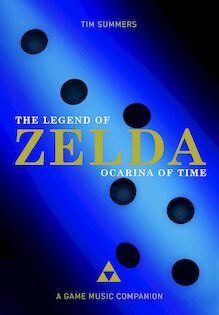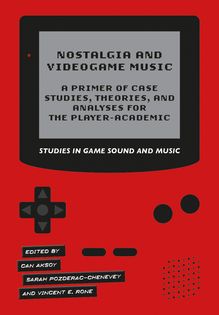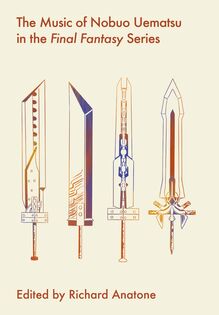-
 Univers
Univers
-
 Ebooks
Ebooks
-
 Livres audio
Livres audio
-
 Presse
Presse
-
 Podcasts
Podcasts
-
 BD
BD
-
 Documents
Documents
-
- Cours
- Révisions
- Ressources pédagogiques
- Sciences de l’éducation
- Manuels scolaires
- Langues
- Travaux de classe
- Annales de BEP
- Etudes supérieures
- Maternelle et primaire
- Fiches de lecture
- Orientation scolaire
- Méthodologie
- Corrigés de devoir
- Annales d’examens et concours
- Annales du bac
- Annales du brevet
- Rapports de stage
La lecture à portée de main
Vous pourrez modifier la taille du texte de cet ouvrage
Découvre YouScribe en t'inscrivant gratuitement
Je m'inscrisDécouvre YouScribe en t'inscrivant gratuitement
Je m'inscrisEn savoir plus
Vous pourrez modifier la taille du texte de cet ouvrage
En savoir plus

Description
Nobuo Uematsu is one of the most influential Japanese composers of the current age. One of Japan’s most beloved living composers, he has been composing music for the popular franchise since 1987, inspiring a new generation of classical music fans, and named by Time Magazine as an ‘innovator’ of the new wave of music.
Sometimes described as the Beethoven of video game music, Nobuo Uematsu has built his career and reputation from his soundtracks to the enduring Final Fantasy series of video games, which are notable for their remarkable cinematic feel.
Classic FM radio describes Nobuo as ‘part John Williams, part Wagnerian leitmotif, part new-age soundscaper – and a legend in his own right’. He has so far appeared five times in the top 20 of the annual Classic FM Hall of Fame, voted for by listeners.
This is the first book-length study on the music of Uematsu. It takes a variety of different analytical approaches to his music. It offers readers interested in ludomusicology (the study of and research into video game music) a variety of ways in which to understand Uematsu’s compositional process and the role that video game music has in the overall gaming experience.
Those interested in Uematsu’s music will gain a greater appreciation and understanding of his compositional processes and his interaction with musical narrative, and those interested in ludomusicology in general will be shown various methodologies that can be applied to a single composer. Those interested in composing for video games or movies will also be given insight into how they might compose for a narrative themselves.
Professional musicians will gain deeper insight into the music from selected games in the series, as each chapter applies traditional theoretical and musicological methodologies to selected games from the series. It my also be a useful educational resource for use in their own studies by student and amateur musicians.
Foreword by William Gibbons, associate professor of musicology at Texas Christian University. Editor Richard Anatone is a professor of music theory at Prince George's Community College in Largo, Maryland.
It will be a valuable resource for ludomusicologists, as well as academics from a variety of disciplines who work in popular music and culture, film and visual media, and subjects traditionally marginalized by the Western 'Classical' canon. It will also be of interest to fans of the Final Fantasy series, both inside and outside of academia and to composers of video game music.
It will also appeal to readers interested in the business and marketing side of the video game industry, and who want to learn from the successes of live video game concerts and how symbolism and thematic interplay aids in drawing gamers’ attention to soundtracks and concerts of video game music.
Game developers will learn how to recognize potential composers and compositional approaches that will aid in storytelling, fandom and gamer immersion.
General video game historians who want to learn more about Square’s early years and eventual transition into a powerhouse development company will also find much to interest them.
While there have been several edited collections in the subdiscipline of ludomusicology, this is the first book to address a composer’s oeuvre as the main subject. It brings together a variety of methodologies and voices on the subject, and has potential to become a model for future composer-focused studies.
Foreword: Dear Friends – William Gibbons
Introduction – Richard Anatone
PART 1: CONERIA CASTLE
1. Dancing Mad: Music and the Apotheosis of Villainy in Final Fantasy – Jessica Kizzire
2. The Devil in the Detail: Analyzing Nobuo Uematsu’s “One- Winged Angel” from Final Fantasy VII – James S. Tate
3. Changing Times: The Diatonic Rhythms of Nobuo Uematsu’s Final Fantasy Battle Music – Ross Mitchell
PART 2: NIBELHEIM
4. Thus Spake Uematsu: Satirical Parody in the Opening Sequence to Final Fantasy VI – Richard Anatone
5. That Tune Really Holds the Game Together: Thematic Families in Final Fantasy IX – Sean Atkinson
6. A Link between Worlds: The Construction of Nostalgia in Game Music and Final Fantasy IX – James L. Tate
PART 3: THE LUNAR WHALE
7. Penultimate Fantasies: Compositional Precedents in Uematsu’s Early Works – Alan Elkins
8. Music and Narrative Experience in Final Fantasy XIV: A Realm Reborn – Stephen Tatlow
9. Music, Mediation, Memory: Theatrhythm Final Fantasy – Julianne Grasso
PART 4: THE WORLD OF BALANCE
10. Feminine Themings: The Construction of Musical Gendering in the Final Fantasy Franchise – Thomas B. Yee
11. Uematsu’s Postgame: The Music of Final Fantasy in the Concert Hall (and Beyond) – Stefan Greenfield- Casas
12. Historical Narratology and the “Hymn of the Fayth” in Final Fantasy X – Andrew S. Powell and Sam Dudley
Notes on Contributors
Indexes
Sujets
Informations
| Publié par | Intellect Books |
| Date de parution | 27 avril 2022 |
| Nombre de lectures | 0 |
| EAN13 | 9781789385564 |
| Langue | English |
| Poids de l'ouvrage | 1 Mo |
Informations légales : prix de location à la page 0,4750€. Cette information est donnée uniquement à titre indicatif conformément à la législation en vigueur.
Extrait
The Music of Nobuo Uematsu in the Final Fantasy Series
Studies in Game Sound and Music
Series editors: Melanie Fritsch, Michiel Kamp, Tim Summers, and Mark Sweeney
Intellect’s Studies in Game Sound and Music publishes accessible, detailed books that provide in-depth academic explorations of topics and texts in video game audio. Titles in this series present detailed analysis, historical investigation, and treatment of conceptual and theoretical issues related to game audio.
The series does not seal game audio into a scholarly suburb but is instead outward-looking: it seeks to engage game audio practitioners and researchers from a range of disciplines, including anthropology, performance studies, computer science, media studies, psychology, sociology, and sound studies, as well as musicology.
Titles in the series:
The Legend of Zelda: Ocarina of Time by Tim Summers
Nostalgia and Videogame Music: A Primer of Case Studies, Theories, and Analyses for the Player-Academic edited by Can Aksoy, Sarah Pozderac-Chenevey, and Vincent E. Rone
The Music of Nobuo Uematsu in the Final Fantasy Series edited by Richard Anatone
The Music of Nobuo Uematsu in the Final Fantasy Series
edited by
Richard Anatone
First published in the UK in 2022 by
Intellect, The Mill, Parnall Road, Fishponds, Bristol, BS16 3JG, UK
First published in the USA in 2022 by
Intellect, The University of Chicago Press, 1427 E. 60th Street,
Chicago, IL 60637, USA
Copyright © 2022 Intellect Ltd
All rights reserved. No part of this publication may be reproduced, stored in a retrieval system, or transmitted, in any form or by any means, electronic, mechanical, photocopying, recording, or otherwise, without written permission.
A catalogue record for this book is available from the British Library.
Copy editor: Newgen
Cover designer: Tanya Montefusco
Production manager: Sophia Munyengeterwa
Typesetting: Newgen
Hardback ISBN 978-1-78938-554-0
ePDF ISBN 978-1-78938-555-7
ePub ISBN 978-1-78938-556-4
Part of the Studies in Game Sound and Music series ISSN: 2633-0652 / Online ISSN: 2633-0660
Printed and bound by Lightning Source.
To find out about all our publications, please visit
www.intellectbooks.com .
There you can subscribe to our e-newsletter, browse or download our current catalogue, and buy any titles that are in print.
This is a peer-reviewed publication.
About the Companion Website
https://www.ludomusicology.org/studies-game-sound-music/uematsu-final-fantasy/
A companion website accompanies The Music of Nobuo Uematsu in the Final Fantasy Series . This site includes supplemental musical examples that were unable to be included in this collection. Readers will find endnotes within this collection that direct readers to supplemental examples (e.g., “see Supp. 4.5”) that provide annotated musical examples, tables, charts, and other figures that were not included in this book. Additionally, any updates to the book, additional materials, and corrected errors will be posted to this website.
Contents
List of Illustrations
Foreword: Dear Friends
William Gibbons
Introduction
Richard Anatone
PART 1: CONERIA CASTLE
1. Dancing Mad: Music and the Apotheosis of Villainy in Final Fantasy
Jessica Kizzire
2. The Devil in the Detail: Analyzing Nobuo Uematsu’s “One-Winged Angel” from Final Fantasy VII
James S. Tate
3. Changing Times: The Diatonic Rhythms of Nobuo Uematsu’s Final Fantasy Battle Music
Ross Mitchell
PART 2: NIBELHEIM
4. Thus Spake Uematsu: Satirical Parody in the Opening Sequence to Final Fantasy VI
Richard Anatone
5. That Tune Really Holds the Game Together: Thematic Families in Final Fantasy IX
Sean Atkinson
6. A Link between Worlds: The Construction of Nostalgia in Game Music and Final Fantasy IX
James L. Tate
PART 3: THE LUNAR WHALE
7. Penultimate Fantasies: Compositional Precedents in Uematsu’s Early Works
Alan Elkins
8. Music and Narrative Experience in Final Fantasy XIV: A Realm Reborn
Stephen Tatlow
9. Music, Mediation, Memory: Theatrhythm Final Fantasy
Julianne Grasso
PART 4: THE WORLD OF BALANCE
10. Feminine Themings: The Construction of Musical Gendering in the Final Fantasy Franchise
Thomas B. Yee
11. Uematsu’s Postgame: The Music of Final Fantasy in the Concert Hall (and Beyond)
Stefan Greenfield-Casas
12. Historical Narratology and the “Hymn of the Fayth” in Final Fantasy X
Andrew S. Powell and Sam Dudley
Notes on Contributors
Indexes
Illustrations
Examples
1.1 Nobuo Uematsu, FFVI , “Kefka,” A section.
1.2 Nobuo Uematsu, FFVI , “Kefka,” B section and tag.
1.3 Nobuo Uematsu, FFVI , “Kefka,” C section.
1.4 Nobuo Uematsu, FFVIII , “Fithos Lusec Wecos Vinosec,” melodic comparison.
1.5 Nobuo Uematsu, FFVIII , “The Castle,” B section, melodic comparison.
1.6 Nobuo Uematsu, FFVIII , “The Castle,” C section, melodic comparison.
1.7 Nobuo Uematsu, FFIX , “Dark Messenger,” melodic comparison.
2.1 Nobuo Uematsu, FFVII , “One-Winged Angel,” mm. 1–2 displaying the march ostinato with a clear 4–4 meter.
2.2 Nobuo Uematsu, FFVII , “One-Winged Angel,” mm. 15–18. Harmonic analysis of the fanfare section showcasing the assumed harmony until the repetition of Em7 and the E in the soprano line.
2.3 Nobuo Uematsu, FFVII , “One-Winged Angel,” mm. 21–23.
2.4 Nobuo Uematsu, FFVII , “One-Winged Angel.” Schenkerian analysis of mm. 44–48 showing the delayed perfect authentic cadence.
2.5 Nobuo Uematsu, FFVII , “One-Winged Angel,” mm. 120–25. Schenkerian reduction showcasing the culmination of much of the musical material Uematsu has incorporated to this point. Annotations to score in italics.
2.6 Nobuo Uematsu, Final Fantasy VII Reunion Tracks (CD), “One-Winged Angel” (transcription by author). Here we see a definitive ending in comparison to the infinite loop in the game, finishing with a final “Sephiroth motif.”
3.1 3+3+2 as long and short tones.
3.2 3+3+3+3+4 as long and short tones.
3.3 Nobuo Uematsu, FFI , mm. 1–2, pulsing motive that begins “Battle Scene.”
4.1 (top) Richard Struass, Thus Spake Zarathustra , introduction (reduction); (bottom) Nobuo Uematsu, FFVI , “Omen,” mm. 1–10.
4.2 Nobuo Uematsu, FFVI , “Dancing Mad: Tier 1,” mm. 21–28 (top) showing prominent use of the ascending and descending step; mm. 43–46 (bottom) showing prominent use of the descending step.
4.3 Nobuo Uematsu, FFVI , “Dancing Mad: Second Tier,” the first phrase (left) and second phrase (right).26 Here, the only melodic motive used in the soprano consists of a rising and falling descending semitone.
4.4 Nobuo Uematsu, FFVI , “Fanatics,” mm. 1–8. Note the parallel fifth motion in the voice, reflecting the religious nature of the cult. It should be noted that the rhythmic activity of the tambourine and bass drum is increased to eighth notes at m. 5.
5.1 α section from “Vivi’s Theme.”
5.2 β section from “Vivi’s Theme.”
5.3 “Eye to Eye” theme from FFIX .
5.4 “Song of Memories” theme from FFIX .
6.1 Nobuo Uematsu, “Mystic Mysdia,” FFIV , mm. 1–6 (top); Nobuo Uematsu, “Vivi’s Theme,” FFIX , mm. 1–6 (bottom).
6.2 Nobuo Uematsu, FFIX , “Black Mage Village,” mm. 38–48.
6.3 Nobuo Uematsu, “Mount Gulug,” FFI , mm. 2–9 (top); Nobuo Uematsu, “Gulug Volcano,” FFIX , mm. 6–9 (middle); Nobuo Uematsu, “Gulug Volcano,” FFIX , mm. 18–21 (bottom).
6.4 Nobuo Uematsu, “Locke’s Theme,” FFVI , B section, mm 17–20 (top); “Forever Rachel,” FFVI , mm. 1–4 (bottom).
6.5 Nobuo Uematsu, “Zidane’s Theme,” FFIX , mm. 61–68 (top); “Unrequited Love,” FFIX , mm. 1–8 (bottom).
7.1 The invincibility themes of JJ (by Nobuo Uematsu, top) and Super Mario Bros. (by Koji Kondo, bottom), which both contained a heightened sense of energy and repeating two-chord shuttle. (The two chords in JJ repeat in the second half of the loop.)
7.2 The starkly contrasting “game over” themes of Tobidase Daisakusen (top) and Final Fantasy II (bottom), reflecting the stylistic characteristics of their respective game genres.
7.3 The pre-/post-level music for the final stage of King’s Knight (top) and the “level clear” music from Junko Ozawa’s soundtrack to Tower of Druaga (bottom), which both contain musical features associated with heroic fanfares.
7.4 Nobuo Uematsu, King’s Knight Special , music for “Kahn Cave.”
7.5 Nobuo Uematsu, Final Fantasy , music for “Flying Fortress,” which contains a degree of internal repetition comparable to the dungeon themes of King’s Knight Special . The two-sonority nanoloops in the triangle wave can be seen as akin to the shuttles of previous examples, even though the pulse waves do not participate in the harmonies the triangle wave outlines.
7.6 Nobuo Uematsu, Nakayama Miho no Tokimeki High School , the music during the apology scene with Miho (0:00–0:11). The slow tempo, minor mode, and texture strongly resemble Uematsu’s “game over” music for FFII (see Example 7.2).
9.1 Annotated transcriptions of the first six measures of “Battle” in Theatrhythm Final Fantasy , originally from FF (1987). The “score” for player actions is notated as dots, lines, and arrows (see key) aligning with each measure in common (4/4) time.
12.1 Nobuo Uematsu, FFX , “Hymn of the Fayth.” Transcription by authors.
12.2 Nobuo Uematsu, FFX , “Song of Prayer.” Transcription by authors.
12.3 Nobuo Uematsu, FFX , “Grand Maester Mika,” 0:00–0:15. Transcription by authors.
12.4 Nobuo Uematsu, FFX , “Hymn–Yunalesca.” Transcription by authors.
12.5 Junya Nakano, FFX , “A Contest of Aeons.” Transcription by authors.
Figures
1.1 Nobuo Uematsu, FFVI , “Kefka,” form.
1.2 Nobuo Uematsu, FFVIII , “The Castle,” form.
3.1 Clock diagram of 3+3+2 rhythm (maximally even, diatonic).
3.2 Clock diagram of 1+3+4 rhythm (not maximally even, not diatonic).
3.3 Clock diagram of 3+3+2+2+2 rhythm (not maximally even, not diatonic).
3.4 Clock diagram of 3+2+3+2+2 rhythm (maximally even, diatonic).
3.5 Venn diagram illustrating the crossover between di
-
 Univers
Univers
-
 Ebooks
Ebooks
-
 Livres audio
Livres audio
-
 Presse
Presse
-
 Podcasts
Podcasts
-
 BD
BD
-
 Documents
Documents
-
Jeunesse
-
Littérature
-
Ressources professionnelles
-
Santé et bien-être
-
Savoirs
-
Education
-
Loisirs et hobbies
-
Art, musique et cinéma
-
Actualité et débat de société
-
Jeunesse
-
Littérature
-
Ressources professionnelles
-
Santé et bien-être
-
Savoirs
-
Education
-
Loisirs et hobbies
-
Art, musique et cinéma
-
Actualité et débat de société
-
Actualités
-
Lifestyle
-
Presse jeunesse
-
Presse professionnelle
-
Pratique
-
Presse sportive
-
Presse internationale
-
Culture & Médias
-
Action et Aventures
-
Science-fiction et Fantasy
-
Société
-
Jeunesse
-
Littérature
-
Ressources professionnelles
-
Santé et bien-être
-
Savoirs
-
Education
-
Loisirs et hobbies
-
Art, musique et cinéma
-
Actualité et débat de société
- Cours
- Révisions
- Ressources pédagogiques
- Sciences de l’éducation
- Manuels scolaires
- Langues
- Travaux de classe
- Annales de BEP
- Etudes supérieures
- Maternelle et primaire
- Fiches de lecture
- Orientation scolaire
- Méthodologie
- Corrigés de devoir
- Annales d’examens et concours
- Annales du bac
- Annales du brevet
- Rapports de stage








